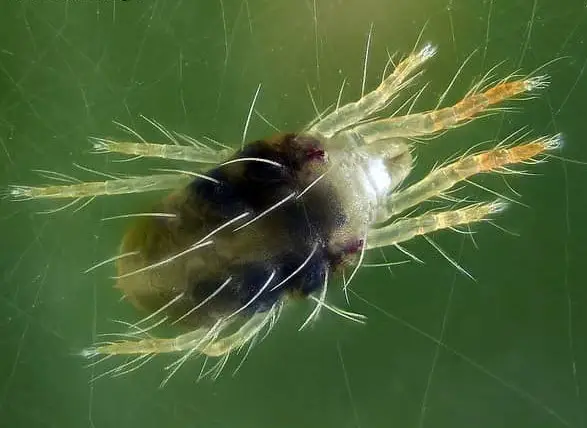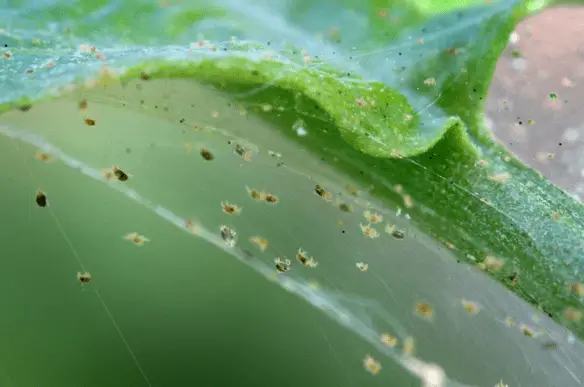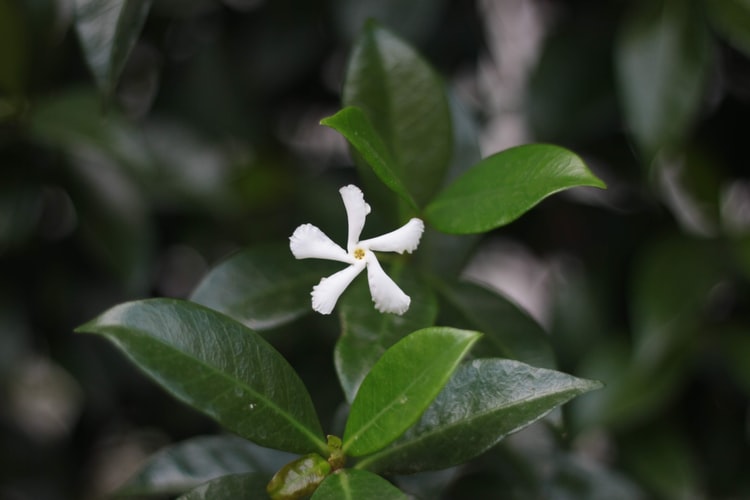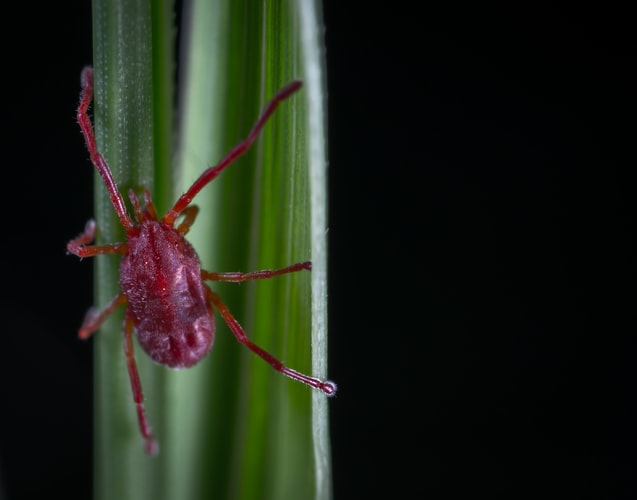Cultivating potatoes is a very easy task. It does not require much effort. In this article, I will introduce to you the types of potato diseases that occur at the foliage level and the type that affects the potato itself (tubers.)
The potato crop, like any other crop, is at risk of several diseases. These diseases can be either caused by bacteria, fungi, insects, viruses, or viroids. They can lead to a negative impact on the quantity and quality of the crop. According to a study (1985), potatoes can be infected by more than:
- 38 types of fungi.
- 6 types of bacteria.
- 23 viruses.
- 2 mycoplasma.
- 68 types of nematodes
- 128 insects, and mites.
They differ in their prevalence from one country to another. However, in this article, I will mention the top most common diseases that affect potatoes.
Bacterial Potato Diseases
Here is a list of the most common bacterial diseases that infect potatoes:
1. Common Scab
Common Scab is a common fungal infection of potato beds. The causative agent of Common Scab is a bacteria called Streptomyces.
Scab’s preferred environment is dry sandy soil with a low to medium acidity level. This type of bacteria tends to be at temperatures from 77 ° F to 82 ° F (25 ° C to 28 ° C.)
Symptoms:
- Small brown lesions, sometimes with shades of red or purple.
- A rough surface of potato tubers.
In severe infestation cases of potato tubers, the foci of the lesion increase in size and then begin to harden and crack. The result of the process leads to a rotted crop.
2. Blackleg & Bacterial Soft Rot
This disease is caused by a bacteria called Erwinia Carotovora. This disease is more prevalent in wet humid areas. This bacteria causes what is known as soft rot. The infection can occur in the field or warehouse.
Wounds are the main cause of this illness where the potato becomes vulnerable. The development of blackleg and bacterial soft rot requires the availability of high levels of moisture in the soil, and insects are one of the most important factors that contribute to the spread of the disease.
Symptoms:
Once the tubers of the potato are infected, they develop soft rot with an unpleasant odor resembling the smell of rotting fish. You can also start to notice the soil texture changes. Its moisture texture increases.
On the level of the foliage, you will start to notice compact foliage, curled upper leaves, stunting, and the leaves’ color becomes yellowish.
When the disease progresses, the whole plant’s color turns yellow and slowly dies. If you pull the plant, you’d notice that the plant has slimy, black, mushy stems. These black stems are what is called “blackleg, ” while the soft rot is for the slimy rot tubers (without the dark color)
3. Bacterial Wilt
This disease is also known as brown rot, southern wilt, sore eye, and jammy eye. It is extremely dangerous as it is destructive to the potato crop. Bacterial wilt has a great effect in warm, tropical, and semi-tropical areas. It is less dangerous in cold areas since the bacteria cannot resist cold weather. However, that does not mean that this bacteria doesn’t exist in cool places.
Bacterial wilt is caused by a bacterium called Ralstonia solanacearum (Pseudomonas solanacearum.) This disease develops at moderate temperatures and high soil moisture.
Symptoms:
In the early stages, the disease appears by sudden wilt on seedlings which leads to direct short death. As for larger plants, they show signs of wilt on the plant itself and the leaves as a result of blockage. The foliage will also change in color to become paler and yellow.
Also, the leaves start to fall off. The plants, unfortunately, will die shortly after you notice these signs. Additionally, some signs will also show on the tubers. You will notice a discharge from the eyes of the tubers.
4. Potato Ring Rot
Ring rot is one serious disease that affects plants and tubers. It appears from the middle to the end of the growing season. It is caused by a bacteria called Corynebacterium Sepedonicum (Clavibacter Michiganensis.)
Symptoms:
This disease can cause plants to wilt. The leaves turn yellow and start to curl. Potato ring rot disease got its name from the soft rotting of the vascular ring. If the disease is severe, the vascular ring rots completely rot and the skin of the potato may crack.
Its symptoms are usually confused with brown rot (bacterial wilt)
Fungal Diseases
1. Late Blight
Potato late blight is one of the worst problems growers face. It is caused by the Phytophthora infestans fungus.
Symptoms:
You can identify late blight by blackish/brown lesions on leaves and stems. In the beginning, these spots appear small and then gradually grow larger and expand until it covers the whole leaf.
After the development of the disease, you can also start to notice white mildew at the edges of the lesions.
2. Early Blight
Potato early blight is a fungal disease that appears on potatoes. It is caused by two different species of fungi, but they are closely related: Alternaria tomatophila and Alternaria solani. This fungus lives in soil and plant debris. They prefer to grow in warm, high-humidity environments. Therefore, potato early blight prefers warm temperatures.
Symptoms:
Despite the name “early blight,” overlapping mall dark spots can be seen on the lower and older leaves of the plant. It also causes tuber blight on potatoes.
3. Black Scurf (Black Rhizoctonia)
This disease affects the parts of the plant that are below the surface of the soil, and it may also be called canker stem or air tuber disease. Black Scurf is caused by a fungus called Rhizoctonia solani. This fungus has many other families.
Symptoms:
You can start to notice that long, irregular-shaped ulcers obtain a brown dark color.
Additionally, the plant blooms above the surface of the soil and forms aerial tubers. Through time, the plant becomes yellow.
Note that this disease also infects the tubers.
4. Dry Rot
This fungal disease is caused by a number of Fusarium species including F. eumartii, F. oxysporum, F. avenaceum, and F. solani. The mere presence of Fusarium does not mean the occurrence of disease, because Fusarium is a genus that contains more than ten species, some of which are pathogenic to potatoes, and some are not.
Symptoms:
Early symptoms appear in the form of yellowing between the veins of the young leaves. Over time, all leaves become yellow, wither, dry, and stay hanging in the stem. Some other noticeable symptoms are leaves curling at the top creating a shape of a rose and the color becomes purple.
Dry rot shrinks the tuber and rots it.
5. Verticillium Wilt
Verticillium wilt, also called early die complex, is a fungal disease caused by either verticillium albo-atrum or Verticillium Dahliae. This illness can cause a huge loss of crops.
Symptoms:
Its symptoms are not specific. However, you can notice that the lower leaves will show chlorosis. Some stems will also start to yellow and eventually die. In severe cases, stem end discoloration can be seen in tubers.
6. Black Dot
Black dot is another fungal disease that affects the roots, stems, and tubers. A fungus called Colletotrichum Coccodes is the cause.
Symptoms:
Black dot is easily confused with Verticillium wilt disease as they both share the same symptoms. In its mid-to-late season, the plants show signs of yellowing and wilting. This disease got its name from the black dots that appear in tubers, stolons, and stems (above and below ground level.)
Tubers will have a brownish-to-gray discoloration covering a large portion of the tuber.
Virus Diseases
1. Potato Leaf Roll (PLRV)
PLRV is a very serious and dangerous virus. It can cause huge yield losses. Potato leaf roll virus infects solanaceous plants. It spreads quickly by aphids, mainly the green peach aphid.
Symptoms:
Usually, the symptoms show on the youngest leaves where the leaf margins become necrotic and turn brownish-purplish. You can also note the leaves start to curl inwards towards the center. The thickness of the upper foliage increases and becomes hard while curled.
The PLRV results in the production of smaller tubers. However, some tubers will retain their normal shape once infected with the virus.
At later stages, the tuber shows small brown spots scattered throughout the tissue.
2. Potato Virus Y (PVY)
This virus spreads very fast. It mostly infects solanaceous plants such as potatoes, tomatoes, and eggplants. This virus also has the ability to spread through infected seeds and seedlings, contaminated tools, and vector insects such as winged aphids.
Symptoms:
Yellow to dark green spots will appear on the edge of the leaf. You can also notice brown or black streaks around the dead plant tissues in the veins of the leaves and branches.
Additionally, the plant stops growing and flowering.
As for the tubers, they would grow small in size and create dead rings on the outer peel. PVY slows and weakens the growth and production of crops.
3. Potato Virus A (PVA)
PVA is another serious virus that can cause great damage in combination with PVX and PVY. Its other names are Potato super mild mosaic and Potato common mosaic.
Aphids as well can transmit PVA, especially vector insects
Symptoms:
For this virus, the symptoms vary depending on the affected variety. In the early stages, you can start to notice a weak mottling and translucency of veins accompanied by a weak corrugation of the edge of the leaves.
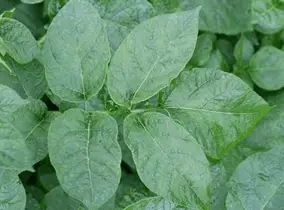
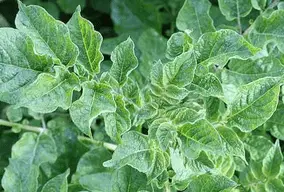
Credit: ephytia.inra.fr
Some leaves will obtain a light green color and curl a little bit. In some cases, the leaves will also have spread small spots.
Symptoms usually disappear as the plant grows.
4. Potato Virus M (PVM)
Another serious risky disease is PVM. It is very common throughout the world. The cause of this virus is the transmission of the aphid Myzus persicae.
Symptoms:
PVM symptoms show on the foliage as big round yellow spots on the surface. The veins become transparent. Other symptoms can show curling on the upper leaves (spoon shape.)
The potato leaf roll virus can show the same symptoms as PVM. The difference lay in the texture of the leaves. Leaves infected with PVM are soft whereas PLRV has a hard texture and is easy to crack.
5. Potato Virus X (PVX)
PVX mainly infects nightshade plants. Infestation can occur through contact with insect vectors from hoppers, contaminated tools, and improper agricultural practices.
Symptoms:
You can notice the symptoms on the leaves as they turn yellow and pale green while curling. The tips of the leaves die and eventually lead to the death of the whole plant.
Some cases show brown spots as well at the level of the foliage.
The symptoms appear distinctly at temperatures between 61°-72° F degrees (16°-22° C). However, in cases of high temperatures, the symptoms may not appear clearly.

Credit: ephytia.inra.fr
6. Potato Virus S (PVS)
The main cause of PVS is the transmission in a discontinuous manner by aphids and agricultural tools. Potato plants tend to resist PVS later in the season.
Symptoms:
The symptoms PVS show depend greatly on different factors such as the environmental conditions of the host plant. Some plants, in the early stages, will show a bronze color or small necrotic spots (black) on the leaves.
Some other cases show symptoms of curling upward and yellowish color begins to develop under the leaves.
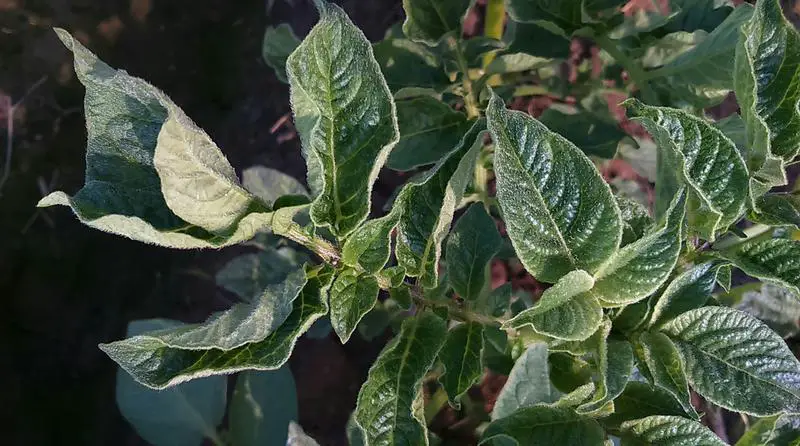
Credit: plantix.net
You’d also note a slight deepening of the veins and coarse leaves. However, some other plants remain asymptomatic, they show no symptoms.
7. Potato Spindle Tuber Viroid (PSTVd)
This virus penetrates plant cells, multiplies in them due to biosynthetic mechanisms in the host plant, and disrupts the life of the whole plant.
Symptoms:
Generally, PSTVd does not cause obvious symptoms. At the level of the foliage, you might start to notice that the leaves become very weak and upright.
The plant will also show a great growth reduction and remains little.
At the level of the tubers, you might find the potatoes elongated, small in size, and cylindrical. The eyes even may look more pronounced than usual which are evenly distributed over the tuber.

